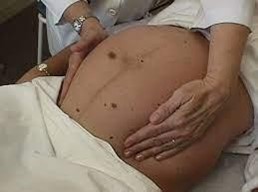A nurse is preparing to auscultate fetal heart tones for a client who is pregnant. Using Leopold maneuvers, the nurse palpates a round, firm, movable part in the fundal portion of the uterus and a long, smooth surface on the mother's right side. In which of the following maternal quadrants should the nurse auscultate fetal heart tones?
Right upper quadrant
Left lower quadrant
Right lower quadrant
Left upper quadrant
The Correct Answer is A
Choice A rationale: Auscultating fetal heart tones in the right upper quadrant is not appropriate based on the information provided by Leopold maneuvers, which indicates the fetal back is on the right side of the mother's abdomen, and the fetal head is in the fundal portion of the uterus.
Choice B rationale: During Leopold maneuvers, the nurse palpated a round, firm, movable part in the fundal portion of the uterus. This finding corresponds to the fetal head, which is typically located at the top of the uterus (fundus). Additionally, the nurse palpated a long, smooth surface on the mother's right side. This finding indicates the fetal back, which typically lies along the right side of the mother's abdomen, suggesting that the fetus's back is positioned anteriorly (toward the mother's front). The location of the fetal heart is typically best heard over the back of the fetus. Therefore, the nurse should auscultate the fetal heart tones in the maternal quadrant corresponding to the back of the fetus, which is the left lower quadrant.
Choice C rationale: The information from Leopold maneuvers does not indicate the fetal back is in the right lower quadrant. The nurse should not auscultate fetal heart tones in this area.
Choice D rationale: Auscultating fetal heart tones in the left upper quadrant is not appropriate based on the information provided by Leopold maneuvers, which indicates the fetal head is in the fundal portion of the uterus and the fetal back is on the right side of the mother's abdomen. The fetal heart is usually best heard over the back of the fetus, which is not in the left upper quadrant.

Nursing Test Bank
Naxlex Comprehensive Predictor Exams
Related Questions
Correct Answer is C
Explanation
Choice A rationale: RhoGAM is not given solely based on blood loss. It is administered to prevent Rh isoimmunization, which is unrelated to the amount of blood loss.
Choice B rationale: If the client has previously given birth to an Rh-negative infant, she is already sensitized and would not require RhoGAM for this current ectopic pregnancy.
Choice C rationale: Rho(D) Immune globulin (RhoGAM) is given to Rh-negative individuals to prevent the development of Rh isoimmunization, which could occur if the client is exposed to Rh-positive blood. In the case of an ectopic pregnancy, there may be a possibility of fetal blood mixing with the mother's bloodstream, which could lead to sensitization in an Rh-negative individual.
Choice D rationale: The desire to conceive again does not dictate the need for RhoGAM. It is solely based on the client's Rh factor status and the potential for sensitization during the ectopic pregnancy.
Correct Answer is C
Explanation
Choice A rationale: While colostrum is present in the first few days after delivery, it takes a few more days for breast milk to "come in" and increase in volume.
Choice B rationale: Waiting for 6 to 8 days for breast milk to come in would be too long after childbirth. Breast milk typically "comes in" sooner, around 3 to 5 days after delivery.
Choice C rationale: Colostrum, the first milk, is typically produced in small amounts during the first few days after delivery. Breast milk usually "comes in" or increases in volume around 3 to 5 days after childbirth. This transition from colostrum to mature milk is normal and expected.
Choice D rationale: Waiting for 10 days for breast milk to come in would be too long after childbirth. Breast milk typically "comes in" sooner, around 3 to 5 days after delivery.
Whether you are a student looking to ace your exams or a practicing nurse seeking to enhance your expertise , our nursing education contents will empower you with the confidence and competence to make a difference in the lives of patients and become a respected leader in the healthcare field.
Visit Naxlex, invest in your future and unlock endless possibilities with our unparalleled nursing education contents today
Report Wrong Answer on the Current Question
Do you disagree with the answer? If yes, what is your expected answer? Explain.
Kindly be descriptive with the issue you are facing.
